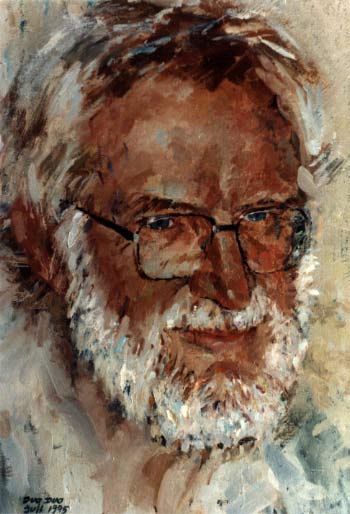
Portrait of Peter Naur painted by
Duo Duo Zhuang, 1995, Oil on
canvas 65x45 cm
Peter Naur, born 1928, Danish scientist, mag. scient. in astronomy 1949, dr. phil. 1957. 1953-59 at Københavns Universitets Astronomiske Observatorium. 1959-69 at Regnecentralen and lecturer at Danmarks Tekniske Højskole and Niels Bohr Institute. 1969-98 professor of Datalogi at Københavns Universitet. Awarded the IEEE Computer Society Computer Pioneer Medal in 1986. Recipient of the ACM A. M. Turing Award 2005

Portrait of Peter Naur painted by
Duo Duo Zhuang, 1995, Oil on
canvas 65x45 cm
ACM has named Peter Naur winner of the 2005 Turing-award, also known as the "Nobel-prize of computing science." The prize will be presented to Peter Naur at a banquet in San Francisco on May 20, 2006.
More about the prize (ACM homepage with press release)
The brief citation for the prize is as follows:
"For fundamental contributions to programming language design and the definition of Algol 60, to compiler design, and to the art and practice of computer programming."
How our mental life happens in our nervous systems
Freely available: Three books and an article
by Peter Naur, winner of the ACM A. M. Turing Award 2005
Psychology – Neurology – without Cognitivism
The neural embodiment of mental life by the synapse-state theory
Mental life as described in William James’s The Principles of Psychology is shown to arise from the excitation activity in a network consisting of nodes, neurons, and synapses. Habits are embodied in the plastic conductivity states of the synapses. The excitation activity is shown to account for all aspects of mental life:
• the stream of thought, including its change from one moment to the next as influenced by feelings;
• things thought of, with their associations, fringes, and the feelings aroused by them;
• attention: the brief accentuation of certain parts of the stream of thought;
• the specious present: retention in the stream of thought, of parts attended to recently, providing the original experience of pastness;
• recall of things thought of previously;
• imagination: recall of sensations of things thought of previously;
• sensations and perceptions of influences on the sense organs, including perceptions of speech sounds and script;
• the muscular activity of speech sound utterances;
• response habits, manifesting themselves in situation-dependent responses, including expressions of personality characteristics such as sexual orientation;
• education of the nervous system from instincts, by imitation;
• personality changes, spontaneous and as induced by hypnosis.
Downloading of the 189 pages of the book: click HERE (1000 kilobytes)
Neural impairments in a case of Alzheimer’s disease
According to the synapse-state theory, the activity of the neural system takes place in a network composed of neurons, nodes, and synapses, of altogether 9 different kinds, distributed into 5 layers: sense layer, motor layer, item layer, attention layer, and specious present layer. It is shown how all the symptoms, introspective as well as behavioral, observed over a period of 4 years in a particular case of Alzheimer’s disease, the case of Iris Murdoch, can be understood to have arisen from the decay, one after the other, of the nodes of the item layer.
Downloading of the 29 pages of the article: click HERE (480 kilobytes)
An anatomy of human mental life
Psychology in unideological reconstruction, incorporating the synapse-state theory of mental life.
Includes detailed criticism of behaviorism and cognitivism.
Downloading of the 283 pages of the book: click HERE
Antiphilosophical Dictionary
Thinking - Speech - Science/Scholarship.
Reveals the philosophical misapprehensions about mental life.
Downloading of the 102 pages of the book: click HERE (824 kilobytes)
Hard copies of the books may be obtained via Ingrid@polyteknisk.dk. Free copies for review may be obtained by application by post mail to the author Peter Naur, Begoniavej 20, DK 2820 Gentofte, Denmark.